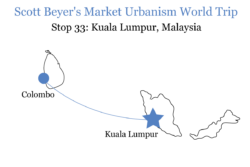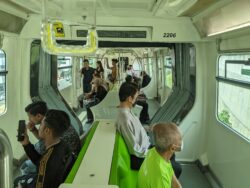Centralized Versus Decentralized Transit
Various Asian regions show a convenience gap between different styles of mass transport.
South Asia and Southeast Asia are a short flight away, but, among the parts of each region I’ve visited on my Global South trip, have very different transit strategies. My South Asian stops of India, Nepal and Sri Lanka have, due to low economic development, makeshift decentralized transit systems. My Southeast Asian stops, which feature economically-advanced countries like Malaysia and Singapore, have centrally-managed transit. This makes getting around the big cities in each region very different, with one type of system proving far more mobile than the other.
The main transit strategy for South Asian cities is micro-mobility. While each city has public transit, their systems aren’t built out so people rely on an omnipresent, often unregulated network of jitney, motorcycle and rickshaw taxis.
My main stops in Southeast Asia have been Kuala Lumpur and Singapore. They have comprehensive public transit systems, including 164-km and 259-km-long rail systems, respectively, and large bus systems. They regulate or ban micro-mobility options.

Here are the results of each. Granted, whether or not one is “better” than the other depends on an individual’s riding priorities:
South Asia’s decentralized system of jitneys, mototaxis and tuktuks
- Private: they are for-profit and have decentralized ownership. Many drivers are either sole proprietors, or rent vehicles from small local management firms.
- Easy payment: quickly negotiate with the driver, and pay afterwards using cash or bank transfer. Services can also be hailed through apps such as Uber or InDrive, which accept credit cards.
- Numerous: vehicles are prolific and available at street level (as seen in the cover photo, shot in Kathmandu). Hailing one is as simple as raising your hand and waiting a minute or two.
- Well-located: relatedly, vehicles camp out where they will find business. This causes the network, rather than occupying a set number of built “stations”, to flood hubs such as malls and hotels where people need the services. The locational setup is thus dictated by market logic, not planning.
- Point-to-point: vehicles in most cases pick you up where you hail them and drop you at your exact destination. Some micro-mobility, such as jitneys and tuktuks, can’t do this when carrying multiple passengers. But they still group people going in the same direction, and even then follow flex routes based on customer need.
- Unsafe: vehicles are too small to withstand collisions, and operators drive them dangerously. Riders are subject to rain, vehicle exhaust and other unpleasantries.
- Congested: because vehicles traverse the streets, rather than going under or above them, they get stuck in traffic. But mototaxis in particular are better at fitting through tight spaces than a normal cab.
Southeast Asia’s centralized rail and bus systems
- Government control: decision-making is taken from the hands of private operators and their customers, and given to unelected bureaucrats. This creates public choice flaws, from poor routing to the constant need for taxpayer subsidy. At worst, it grants abusive political regimes the ability to control how millions of people move.
- Payment difficulties: this has been an age-old friction for transit agencies. While the private sector learns to streamline payment through apps, public systems don’t have these, and often don’t even take credit cards. Figuring out how to pay my fare has been a complication at every stop, and is especially hard in Kuala Lumpur and Singapore, given that they charge based on distance, meaning I have to decipher confusing fare machine maps.
- Fixed stations: the good thing about these is that they spur urban development by signaling to investors that a given block has fixed transit infrastructure. But for users it means lots of walking to find an entry point—these systems seldom take people to their desired A-to-B and back.
- Inaccessible entries: relatedly, rail infrastructure is usually above or below grade, as to require extra time and energy to use the service. Because this setup is inaccessible to the disabled, these stations must then build an expensive network of service elevators and escalators.
- Safety: rail (and sometimes designated arterial buses) are separated from automobile traffic, and not prone to crashes in their own right. Kuala Lumpur, Singapore and other Asian cities also use surveillance and strict policing to keep their transit systems crime-free.
- Decongestion: while it takes more time to enter and exit rail stations, that can be offset if the trip is long and would otherwise go along a congested surface-level road. Rail transit saves time by having its own right-of-way.

*
While I’ve laid out the pros and cons of either system, the verdict on which is better boils down, at least to me, to which one offers better mobility. My answer is the decentralized one—it’s not even close.
Throughout urbanized South Asia, there was seldom a minute that would pass between when my brain realized I needed a ride, and when I boarded onto one. Often drivers themselves were the ones putting the idea in my head, barking out their services from every corner. It was like having a city full of personal chauffeurs.
But getting around Kuala Lumpur and Singapore is a chore. Plug a destination into Google Maps, and it spits out a transit route that requires walking, upward and downward escalating, and familiarity with the system. Often I’ll just e-hail a cab, which themselves can take 10+ minutes to arrive.
It’s a loss of freedom that occurs (perhaps ironically) when shifting from a 3rd World to 1st World setting.
All images credited to Scott Beyer and The Market Urbanist.
Catalyst articles by Scott Beyer | Full Biography and Publications
